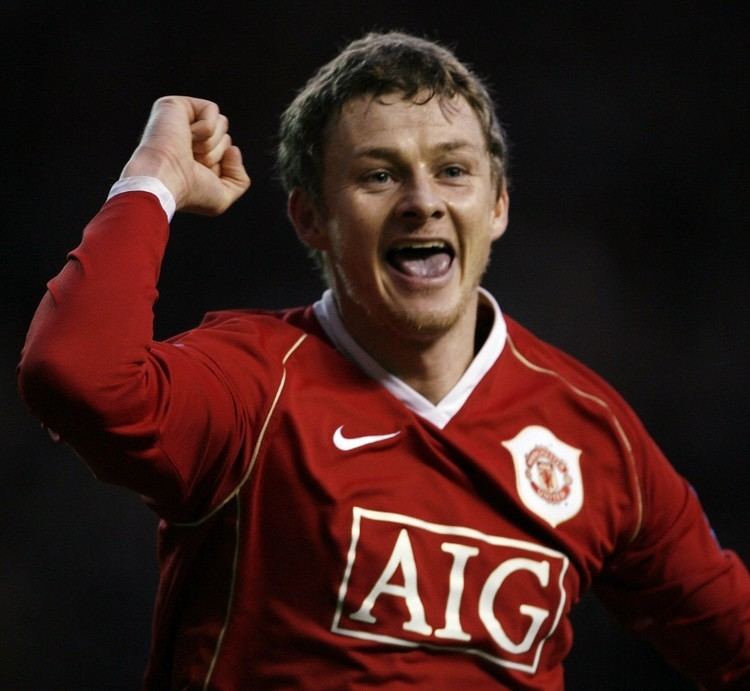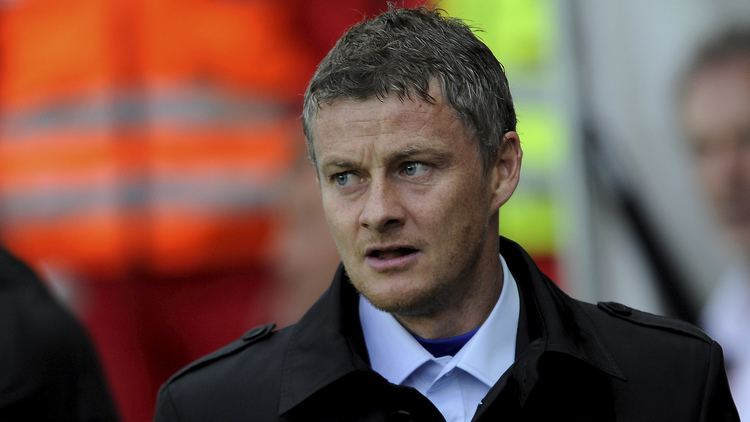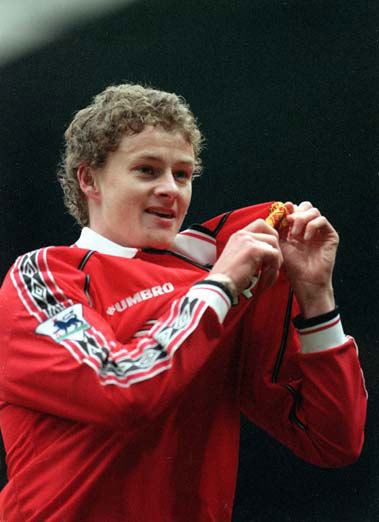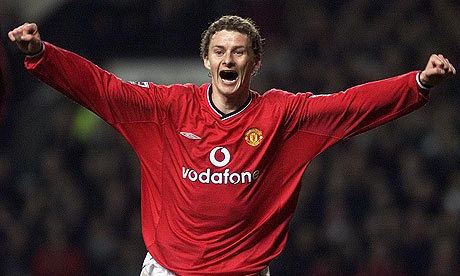Full name Ole Gunnar Solskjaer Playing position Role Football manager Weight 74 kg Parents Oivind Solskjaer | Name Ole Solskjaer Height 1.78 m Spouse Silje Solskjaer | |
 | ||
Date of birth (1973-02-26) 26 February 1973 (age 44) Children Karna Solskjaer, Elijah Solskjaer, Noah Solskjaer Similar People | ||
FM19 Experiment | Ole Gunnar Solskjaer | Man Utd | Mourinho Sacked | Football Manager
Ole Gunnar Solskjær ([ˈuːlə ˈɡʉnɑr ˈsuːlˈʂær]; born 26 February 1973) is a Norwegian football manager and former player. As a player, he spent most of his career playing as a forward for Manchester United. He is the manager of Molde FK.
Contents
- FM19 Experiment Ole Gunnar Solskjaer Man Utd Mourinho Sacked Football Manager
- Ole gunnar solskj r manchester united legend
- Early career
- Manchester United
- International career
- First step into coaching
- Molde
- Cardiff City
- Return to Molde
- Personal life
- Managerial statistics
- Player
- Manager
- Individual
- References

Before his arrival in England, Solskjær played for Norwegian clubs Clausenengen and Molde. He joined Manchester United in 1996 for a transfer fee of £1.5 million. Nicknamed "The Baby-faced Assassin", he played 366 times for United, and scored 126 goals during a successful period for the club. He was regarded as a "super sub" for his trait of coming off the substitute bench to score late goals. Solskjær's defining moment in football came in injury time of the 1999 UEFA Champions League Final, where he scored the winning last-minute goal against Bayern Munich, completing a remarkable comeback and winning The Treble for United. Before the century was up, a biography was written on him.

In 2007, Solskjær announced his retirement from football after failing to recover from a serious knee injury. However, he remained at Manchester United in a coaching role as well as in an ambassadorial capacity. In 2008, Solskjær became the club's reserve team manager. He returned to his native country in 2011 to manage his former club, Molde, whom he led to their two first ever Norwegian league titles in his first two seasons with the club. He secured a third title in as many seasons, when his team won the 2013 Norwegian Football Cup Final. In 2014 he served as manager of Cardiff City, during which the club were relegated from the Premier League.

He also supervises a training academy for young footballers in his home town of Kristiansund, and is a patron of the Manchester United Supporters' Trust.

Ole gunnar solskj r manchester united legend
Early career
Born in Kristiansund, Møre og Romsdal, Solskjær completed a year's national service in the Norwegian Army, before signing the same year with Norwegian Third Division side Clausenengen. Solskjær impressed in the Otta Cup as a 17-year-old with seventeen goals in six matches. He spent five years playing for the club, averaging more than a goal a game over the period. Solskjær scored 31 of Clausenengen's 47 goals in the 1994 Norwegian Second Division.

Ahead of the start of the 1995 season (1 January), he was signed by Åge Hareide, manager of the Norwegian Premier League side Molde FK, for a fee of NOK200,000. In his first season at Molde, he scored 20 goals in the 1995 Norwegian Premier League.
Solskjær scored 31 goals in 38 matches for Molde in the Norwegian Premier League, leading to interest from Hamburger SV of Germany and Italian club Cagliari. Molde's then-manager, Åge Hareide, made Solskjær available to both Everton and Hareide's old club Manchester City for £1.2 million. However, neither Everton nor City were willing to take a risk on Solskjær, and the interest from Hamburg and Cagliari fell through after Manchester United submitted a bid of £1.5 million during Euro 1996, which Molde accepted.
Manchester United
Early Manchester United years
Solskjær joined Manchester United on 29 July 1996, and was something of a surprise acquisition as he was almost unknown outside his homeland and at the time United were still in the hunt for Blackburn Rovers and England striker Alan Shearer, who then joined Newcastle United for a world record £15 million. As the only striker to arrive at Old Trafford that year, it was widely expected that his first season would be spent as a backup to Eric Cantona and Andy Cole with only occasional first team opportunities. But within weeks of his arrival it was clear that he would be a key part of the first team sooner than had been anticipated, and would also prove himself to be one of the biggest Premier League bargains of the season.
He was issued with the number 20 shirt, a squad number he would retain for the rest of his Manchester United career. He scored six minutes into his debut as a substitute against Blackburn Rovers. Solskjær scored 18 Premier League goals for United in his first season, helping United win the title in the last weeks of the season. The British media nicknamed him the "Baby-faced Assassin" because of his youthful looks and his deadly finishing.
He will perhaps be best remembered as a "super-sub", having earned wide acclaim for a habit of coming into matches late on as a substitute and scoring goals. Alex Ferguson remarked that Solskjær has a knack of sitting on the bench and studying the game without taking his eye off the action. Reflecting on this aspect of his career years later, Solskjær said: "I had to think about myself, how can I do the most damage for the opposition if I come on? I sat there and I studied football games but I didn't exactly analyse their strikers. [...] Instead I would pay attention to what the defenders and full-backs were doing wrong."
One of his most impressive feats was coming off the bench to score four goals in the last 12 minutes of United's 8–1 win over Nottingham Forest during their treble-winning 1998–99 season. He scored another four goals in a match a season later against Everton in a 5–1 victory.
Solskjær stayed at Old Trafford even though other clubs showed interest in the player in 1998. He refused an offer from Tottenham Hotspur, after Manchester United had accepted a bid for him. The Norwegian went on to score the stoppage time winning goal against Bayern Munich in the 1999 UEFA Champions League Final, helping the team secure the Treble and cementing his own place in the United folklore. Another defining moment in his career, was in the end of the league match against Newcastle United in 1998. The match was tied at 1–1, and Manchester United needed at least a draw to keep up with Arsenal in the race for the league title. Near the end of the game, Newcastle's Robert Lee had a clear goalscoring opportunity, running unopposed towards United's goal, but Solskjær had run across the entire field to commit a professional foul against him, thus denying Newcastle a winning goal. Solskjær did this knowing he would be sent off, and suspended for the coming matches. Supporters regarded this as an example of how Solskjær put the club above personal interest.
After a few years of coming on as the super-sub, Solskjær got a chance as a starter in the 2001–02 season, paired up with Dutch striker Ruud van Nistelrooy. He took the opportunity with characteristic incisiveness, forcing Andrew Cole and Dwight Yorke onto the bench.
By 2002–03, after both Andrew Cole and Dwight Yorke had left Old Trafford, Solskjær had only Diego Forlán and Van Nistelrooy to compete with for a place in the starting line-up. Ferguson's persistence in playing Van Nistelrooy up front with Paul Scholes, or as a lone striker, meant that opportunities were limited.
Solskjær was subsequently given his time again when David Beckham picked up an injury and Ferguson played the Norwegian on the right wing. While proving himself to be an able crosser of the ball, Solskjær also continued to contribute with goals, scoring a total of 16 goals in the season. He was selected to play on the right in important matches, such as in the league game against Arsenal and the Champions League quarter-final against Real Madrid, while Beckham was left on the bench. He also captained the team in a number of matches.
Injury-plagued seasons
At the start of 2003–04, Solskjær found himself as United's first-choice right winger. However, a knee injury suffered against Panathinaikos on 16 September 2003 put Solskjær out of action until February 2004. Solskjær returned from the injury for the season run-in and was man of the match in the FA Cup semi-final victory over Arsenal. He also played in the 2004 FA Cup Final, which the club won. Solskjær was forced to undergo intensive knee surgery in August 2004 and had to miss the 2004–05 season entirely. While he eventually recovered his fitness, it was difficult for the 32-year-old to carve his niche again among the heavy-weight attack of Manchester United. The Old Trafford faithful, however, displayed almost fanatical loyalty in their desire to see Solskjær in action again.
To show their continuing support, fans added a banner to the collection that lines the Stretford End reading "20 LEGEND" (Solskjær wore number 20 for United). Solskjær further solidified his status amongst United fans when he became a patron of the supporters action group, Manchester United Supporters Trust (MUST), previously Shareholders United.
Back from injury
Solskjær made his long-awaited return to action on 5 December 2005, playing for United's reserves against Liverpool. Spectators numbering 2,738 showed up to witness the comeback of the popular Norwegian – an above-average turn-out for a reserve team match. He made his first-team return as a substitute in the match against Birmingham City on 28 December. He then finally made his first start more than a year later in the FA Cup match against Burton Albion, before playing a full game as a captain in the replay. His return to full fitness slowly continued with regular appearances in the reserves, until on 8 March 2006 when, during a game against Middlesbrough, he was accidentally caught by Ugo Ehiogu, breaking his cheekbone. While facing the possibility of missing the rest of the season, he nevertheless appeared as a substitute against Sunderland on Good Friday. Solskjær had a very successful pre-season tour in the summer of 2006 gaining Ferguson's praise who also said he would reconsider his plan to buy a new striker. He returned to Premier League action on 23 August 2006 when he scored in an away match against Charlton Athletic, his first Premier League goal since April 2003. Ferguson commented after the match that "it was a great moment for Ole, United fans everywhere, the players and the staff" and that "Ole has been through a torrid time with injuries for the last two years, but he's persevered and never lost faith and has got his repayment tonight. Everyone is over the moon for him." He continued his come-back by putting in the winning goal in the Champions League group match against Celtic on 13 September, fulfilling his post-injury ambition to score another goal at Old Trafford. Solskjær's first Premier League goal at Old Trafford since his return came on 1 October when he scored both goals in the 2–0 win against Newcastle United. His goalscoring form continued with when he started the away match against Wigan Athletic and struck a sublime finish to round off a 3–1 victory, and again against Crewe Alexandra on 25 October 2006, scoring the first of a 2–1 victory. After a further injury sustained in Copenhagen, Solskjær again returned on form scoring the third goal in the 3–1 win over Wigan on Boxing Day. Solskjær continued his form by scoring United's opening goal in their 3–2 win over Reading on 30 December. Additionally, he came on as a substitute to score an injury-time winner in the 2–1 victory over Aston Villa in the 3rd Round of the FA Cup on 7 January 2007.
After a match against Reading, Solskjær had further surgery on his knee. However, it was not as serious as his previous operations, and he was put out of action for only a month. He was predicted to be available for the 31 March game against Blackburn Rovers. United manager Alex Ferguson said: "It was good timing with the international break coming up. It gave us the opportunity to get the thing done." Solskjær did make his comeback from injury against Blackburn Rovers as a late substitute, and even scored in the 89th minute to seal Manchester United's 4–1 win. His last match was the 2007 FA Cup Final against Chelsea which did not provide him with a fairy tale ending as an extra-time goal from Didier Drogba gave Chelsea the victory.
On 5 June 2007, it was announced that Solskjær had undergone minor surgery after he reported discomfort in his knee while training with Norway. The surgery was a success, but Solskjær failed to fully recover and announced his retirement from professional football on 27 August 2007. On 4 September, at a home game against Sunderland, Solskjær walked onto the pitch to say goodbye to the fans and received a standing ovation. As of his retirement, Solskjær held the record for the most goals scored for Manchester United as a substitute, scoring 28 goals off the bench, as well as the most Premier League goals as a substitute with 17 (a mark since passed by Jermain Defoe).
Testimonial
On 2 August 2008, a testimonial was played in honour of Solskjær at Old Trafford against Espanyol. Almost 69,000 fans were present, thereby setting a record as the second-highest-attended testimonial in British history. United eventually got the winner from substitute Fraizer Campbell. Solskjær appeared in the 68th minute, replacing Carlos Tevez. At the end of the game, he addressed the fans with a speech, thanking the staff, players, fans and his family.
International career
Solskjær made his international debut in a friendly match against Jamaica on 26 November 1995, just a few months before he joined Manchester United. The game finished in a 1–1 draw with Solskjær scoring the only goal for Norway. He continued his great goal scoring start by scoring three goals in his first competitive appearances for the national team during the 1998 World Cup qualifying campaign.
Solskjær played in both the 1998 FIFA World Cup and UEFA Euro 2000 for Norway. He formed a feared partnership with Tore André Flo which was seen as one of the best striking partnerships in Norway's history.
Following his lengthy layout to injuries Solskjær made his full game comeback on 2 September 2006, when he scored the first and last goals in a 4–1 win against Hungary in a Euro 2008 qualifying match. They would be his last goals for the national team taking his tally up to 23 goals.
In February 2007, he made what proved to be his final appearance for Norway against Croatia, finishing with a record of 67 appearances.
First step into coaching
Solskjær signed his last player contract with Manchester United on 31 March 2006, with a provision to allow him to develop his coaching awards. He also acted in an ambassadorial role for the club, when he travelled to Hong Kong in 2006 and played with students at the Manchester United Soccer School in Hong Kong. When interviewed by Setanta Sports in August 2007, Solskjær confirmed he would train to be a coach after retiring from professional football, and would start to earn the required badges after his last season with Manchester United. Following his retirement, Solskjær worked for Sir Alex Ferguson at Old Trafford, coaching the strikers on the first team for the remainder of the 2007–08 season.
As announced on 20 May 2008, he took over the Manchester United Reserves during the summer of 2008. Solskjær was United's first full-time reserve team manager since 2006, taking over from Brian McClair and Jimmy Ryan, who had filled the role in a caretaker capacity. He won the 2007–08 Lancashire Senior Cup by defeating the Liverpool Reserves 3–2 in the final. On 12 May 2010, Solskjær won his first Manchester Senior Cup by defeating Bolton 1–0 at the Reebok Stadium.
Shortly after the resignation of Åge Hareide from the position, Solskjær was offered the opportunity to coach the Norwegian national team; he declined, saying that it was not yet the right time for him to become the Norway coach. Solskjær's final game as Manchester United Reserves manager was a 5–1 victory over Newcastle United on 16 December 2010.
Molde
On 9 November 2010, Solskjær signed a four-year contract with the Norwegian side Molde FK to take over as manager, where he played prior to moving to Manchester United. Solskjær continued as Manchester United Reserves manager until January 2011, when he took over at Molde for the start of the new season.
On 18 March 2011, Molde played their first league game under Solskjær and suffered an embarrassing 3–0 defeat to newly promoted Sarpsborg 08. They played their first home game of the season on 3 April, where despite coming from 1–0 down to lead 2–1 they were held to a 2–2 draw by league leaders Tromsø. Molde's first goal under Solskjær was scored in this game, by Senegalese striker Pape Paté Diouf. On 17 April 2011, Solskjær won his first Tippeligaen game at Molde with the 3–2 home win over Stabæk. On Molde's 100 years anniversary on 19 June 2011, Solskjær lead the team to a 2–0 victory over Sogndal and the top of the Tippeligaen. On 30 October 2011, Solskjær won the Tippeligaen with Molde in his first year as manager for the team.
On 18 May 2012, Molde gave Aston Villa permission to discuss their vacant managerial role with Solskjær, following the sacking of Alex McLeish. However, Solskjær decided to remain with Molde to avoid disrupting his family after they had settled back in Norway.
On 11 November 2012, Solskjær's team, Molde, won the Tippeligaen for the second consecutive year after they beat Hønefoss 1–0, whilst their closest title challengers, Strømsgodset lost 2–1 away to Sandnes Ulf.
In 2013, Molde suffered a tough season opening with only 7 points in the first eleven matches. Under the guidance of Solskjær, Molde managed to recover and at the end of the season the team finished in sixth place with 44 points in 30 matches. On 24 November 2013, Molde beat Rosenborg 4–2 in the 2013 Norwegian Football Cup Final to win the Norwegian Cup for the third time in the club's history, thus securing a place in the 2014–15 UEFA Europa League qualifiers.
Cardiff City
On 2 January 2014, Solskjær was announced as first team manager of Cardiff City. He won his first game in charge after coming from behind to beat Newcastle United 2–1 in the third round of the FA Cup two days later. Cardiff then struggled for points and after damning defeats against Swansea, Hull, Crystal Palace and Sunderland, Cardiff were relegated back to the Championship following a 3-0 away defeat to Newcastle. At the end of the season, Cardiff finished 20th, collecting only 7 wins and 30 points. He departed on 18 September 2014 following Cardiff City's poor run of form at the start of the Championship campaign.
Return to Molde
On 21 October 2015, Solskjær returned to Molde, signing a three-and-a-half-year contract to become their new manager. He guided them to first place in their Europa League group, ahead of Fenerbahçe, Ajax and Celtic. In the last 32, they lost 3–1 on aggregate to holders Sevilla, despite winning the second leg.
Personal life
Solskjær lived in Bramhall with his wife, Silje, and their three children, Noah, Karna and Elijah during their time in England. He then lived in his hometown Kristiansund with his family while at Molde. He has admitted that he is not his son Noah's favourite player – his former United teammate Wayne Rooney is.
In 2008, Solskjær was awarded with the First Class Knighthood of the Royal Norwegian Order of St. Olav by King Harald V of Norway. He was presented with the award in a ceremony on 25 October 2008 in his hometown of Kristiansund. Solskjær is the youngest ever recipient of the knighthood, usually bestowed upon notable members of society in their later years.
In 2009, the Norwegian parliament bestowed upon Solskjær its annual Peer Gynt Prize for his work as worthy ambassador of sport and for his "great social commitment," in a ceremony at Vinstra Hall. The ex-footballer laughingly admitted in the subsequent press conference that he had neither read nor seen the Ibsen play, yet, but now intends to.
In 2010, the Sunday Times Sport Rich List estimated his personal wealth to be around £10 million, making him one of the richest coaches in British football. After he purchased a house in his home town Kristiansund, speculation mounted around whether he would succeed Uwe Rösler as manager for Solskjær's former club Molde FK, an hour away from Kristiansund by car.
